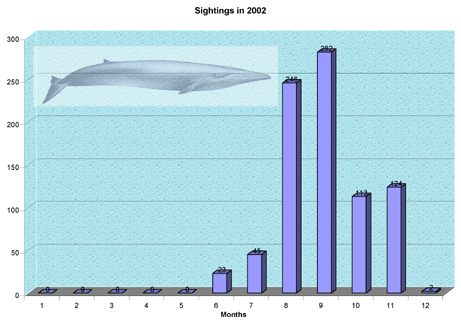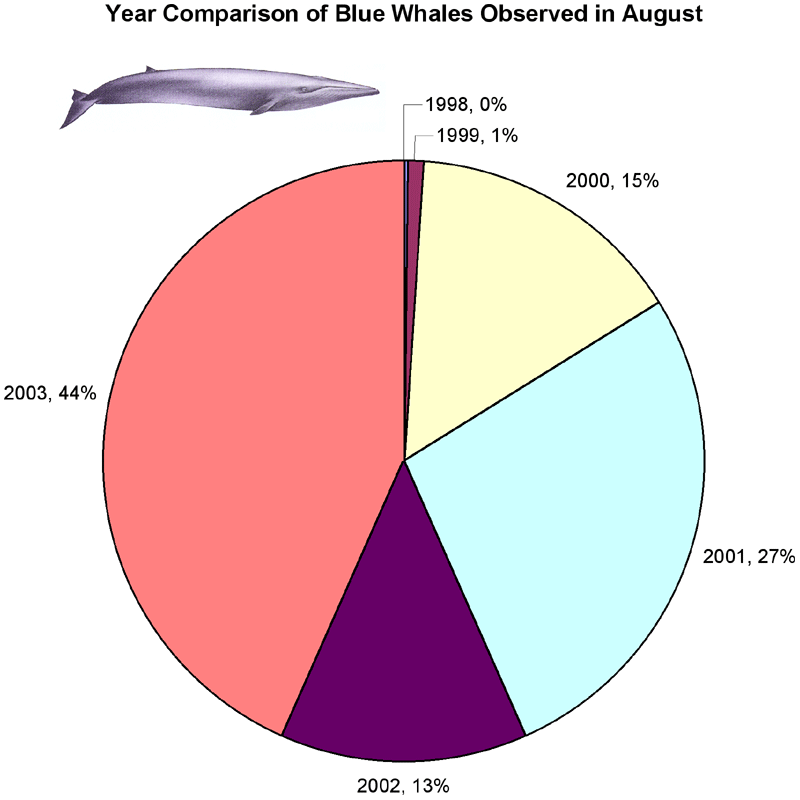Balaenoptera intermedia – Southern Hemisphere
Balaenoptera brevicauda – Tropical Southern Hemisphere
Description: The largest creature ever known to have existed on earth is the present- day blue whale (Yes, they are even larger than dinosaurs!). Today’s blue whale, even larger than its ancestors, may reach a total length of 33m and a weight of 145 tons. Female blue whales are generally larger than males, and northern hemisphere blue whales are generally smaller than those in the southern hemisphere. Like all whales, the blue whale is a mammal rather than a fish. It is warm- blooded, has lungs rather than gills, and nourishes its young with milk. It is blue- grey in color but the true color varies between individuals from a very light blue to a uniform dark slate- grey. Its throat grooves, in addition to streamlining the shape of the whale, allow the throat area (cavum ventrale) to expand tremendously during feeding, and can hold 1,000 tons or more of food and water when fully expanded. The head of the Blue whale forms up to a quarter of the total body length and compared with other rorquals is very broad. It has twin blowholes with exceptionally large fleshy splashguards to the front and sides. The baleen plates in the mouth of the Blue whale can be 90cm- 1m in length the longest of all the rorquals but not the longest of all whales. The underside of the whale is yellow or mustard- colored and is not a natural pigmentation but is caused by the presence of algae, called diatoms, which attach themselves to the whale's body. This is most commonly observed in animals living in cold waters near the poles. The flippers are long and slender and about one seventh of body length.
Other Names: Sulphur- bottom (referring to the yellow-brown appearance of algae on the skin after the whales have inhabited polar waters), Sibbald's Rorqual, and the Great Northern Rorqual.
Status: Endangered
Population: Estimated to be 1,300 to 2,000, the population of blue whales is dangerously low. This is due to the extensive hunt for their large quantities of baleen, blubber, and meat. Although they are protected, their population shows few signs of recovery. Blue whales face constant threats from entanglement in fishing nets, pollution, and illegal whaling. Blue whales were once considered too difficult to hunt because of their speed and tremendous size. However, with the introduction of factory ships and the harpoon gun in the 1920s, blue whales were hunted intensively.
Recognition at sea: Any rorqual exceeding 24m is likely to be a Blue whale. The blue whale’s blow (spout), consists of air and water, slender and is vertical, measuring about 9m (30 feet) in height. Breathing sequence usually involves 2-6 minutes at the surface, blowing once every 10- 20 seconds, followed by a dive for 5- 20 minutes. The fin is visible briefly before the whale arches its back in preparation for the dive. Its tail stock may arch and its flukes may be visible but often they simply sink below the surface.
Habitat: Blue whales generally spend their winters in temperate and subtropical zones, migrating toward the Polar Regions in spring and summer. This in turn can cause entrapment by ice as the weather changes. They swim 14 miles per hour and feed at depths of less than 330 feet. Usually they travel alone or in small groups of two or four, although off the coast of California some groups as large as 60 have been seen. Most blue whales live in the Southern Hemisphere while smaller populations inhibit the North Atlantic and North Pacific. They migrate long distances between long latitude winter mating grounds and high latitude summer feeding grounds and are often seen in parts of California.
Food and Feeding: The main stomach of the Blue Whale can hold a tonne of its primary food source, tiny plankton, which it specializes in consuming in the Antarctic. It's hard to imagine, but the world's biggest animal eats animals that are less than 1/1000th its size. In order to get enough to eat, a full grown blue whale might eat 40 million krill in one day!
Behavior: They are not strictly gregarious in manner, and is usually found in pairs or as a solitary animal. Moans, pulses, clicks, rasps and buzzes, as well as breaching and lob- tailing are the primary means of communication between individuals.
Bottom line facts: While we know a lot about whales and we are learning more every day, there are questions we haven’t been able to answer. We know blue whales migrate from Polar Regions where they feed to warmer, temperate waters where they breed and have their babies but not yet has it been known how these whales can travel such long distances. As the population figure suggests, blue whales have been ruthlessly and relentlessly slaughtered for every reason imaginable, almost to the point of extinction. Now on the endangered list, the Blue whale is protected worldwide by international law. It is not to be hunted by anyone for any reason at all. Suggestion are that some populations may never recover.
DID YOU KNOW?
![]() How blue whales have their young?
How blue whales have their young?
Blue whales begin mating between 5-10 years of age. Females are pregnant for about 11 months and females get pregnant approximately every two to four years. Calves can gain 200 lbs. each day while nursing. Mother and calf form a very close bond, with the baby often swimming close to its mother.
![]() How long do Blue whales live?
How long do Blue whales live?
Between 35- 40+ years
![]() A blue whale heart is the size of
a Volkswagen Beetle and pumps 10 tons of blood through the massive blue whale
body. A blue whale aorta alone is large enough for a human to crawl through.
Fifty people can stand on its tongue.
A blue whale heart is the size of
a Volkswagen Beetle and pumps 10 tons of blood through the massive blue whale
body. A blue whale aorta alone is large enough for a human to crawl through.
Fifty people can stand on its tongue.
 |
According to the data shown; no Blue Whales were spotted at Monterey Bay in the months of February and March. Few were spotted in January, April, and May. During the months of August and September large numbers of Blue Whales were spotted. In August 2003, 813 Blue Whales were cited and 799 in September 2003. In 1998 there were 135 Blue Whales observed in the months of September and October combined. This lack of numbers can be attributed to an El Nino year that reversed the currents off California’s coast affecting upwelling chlorophyll-a concentration, food availability and the breeding pattern of the Whales. Few Whales being spotted in the earlier months and later months of each year can be attributed to their presence elsewhere around the globe. |
| In contrast, the large number of Whales recorded in the months of August and September and to a lesser extent July can possibly be attributed to family groups returning with their new offspring and/or adults coming to feed or breed from polar or warmer waters. The total number of Blue Whales sighted in 1999 (145) is a low value and can be contributed to the lack of success in breeding in 1998 – the El Nino year. We can speculate to their presence in Monterey Bay and the times they are there but with little certainty. Yet, further studies are needed to determine their reasons for visiting us. |  |